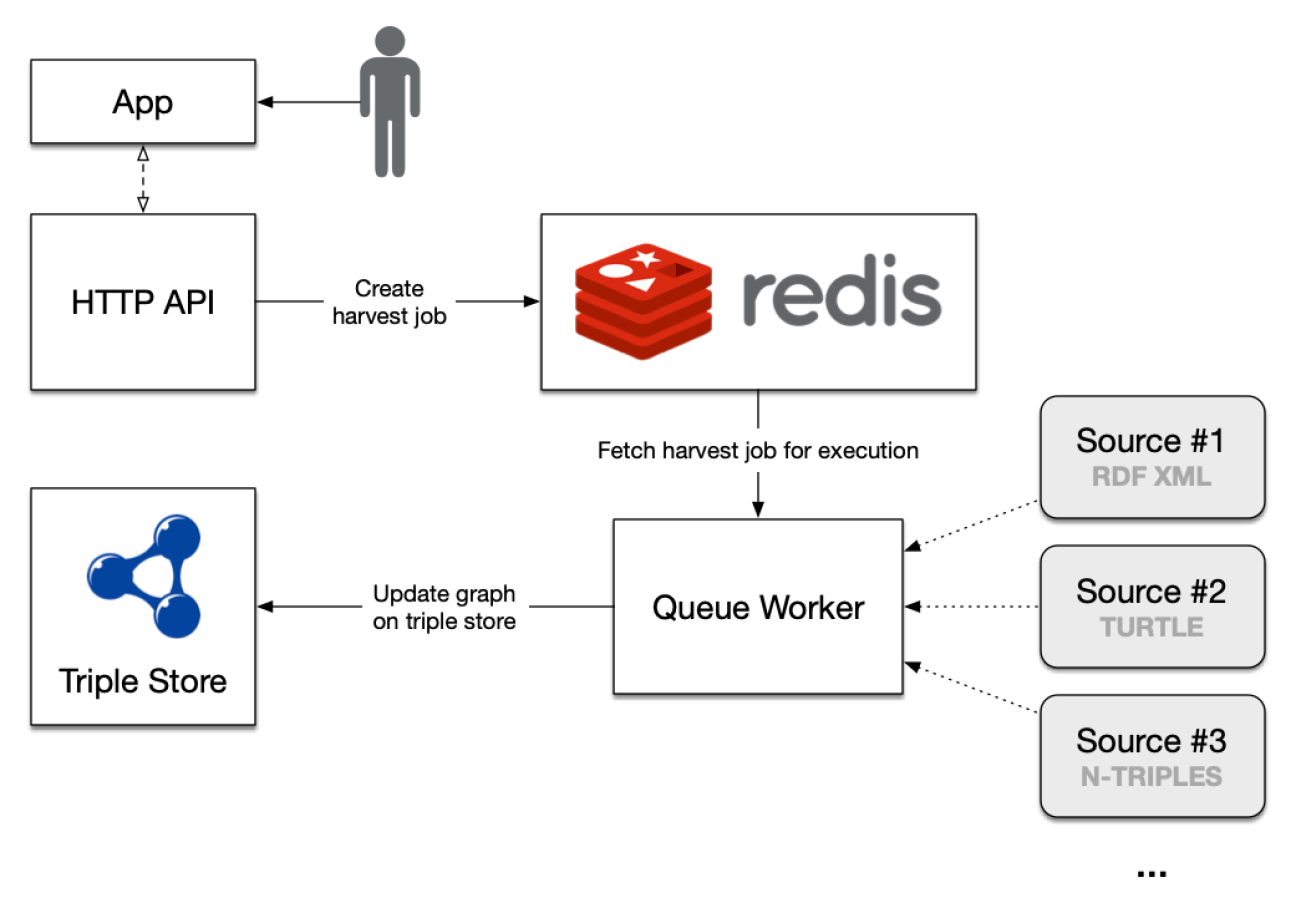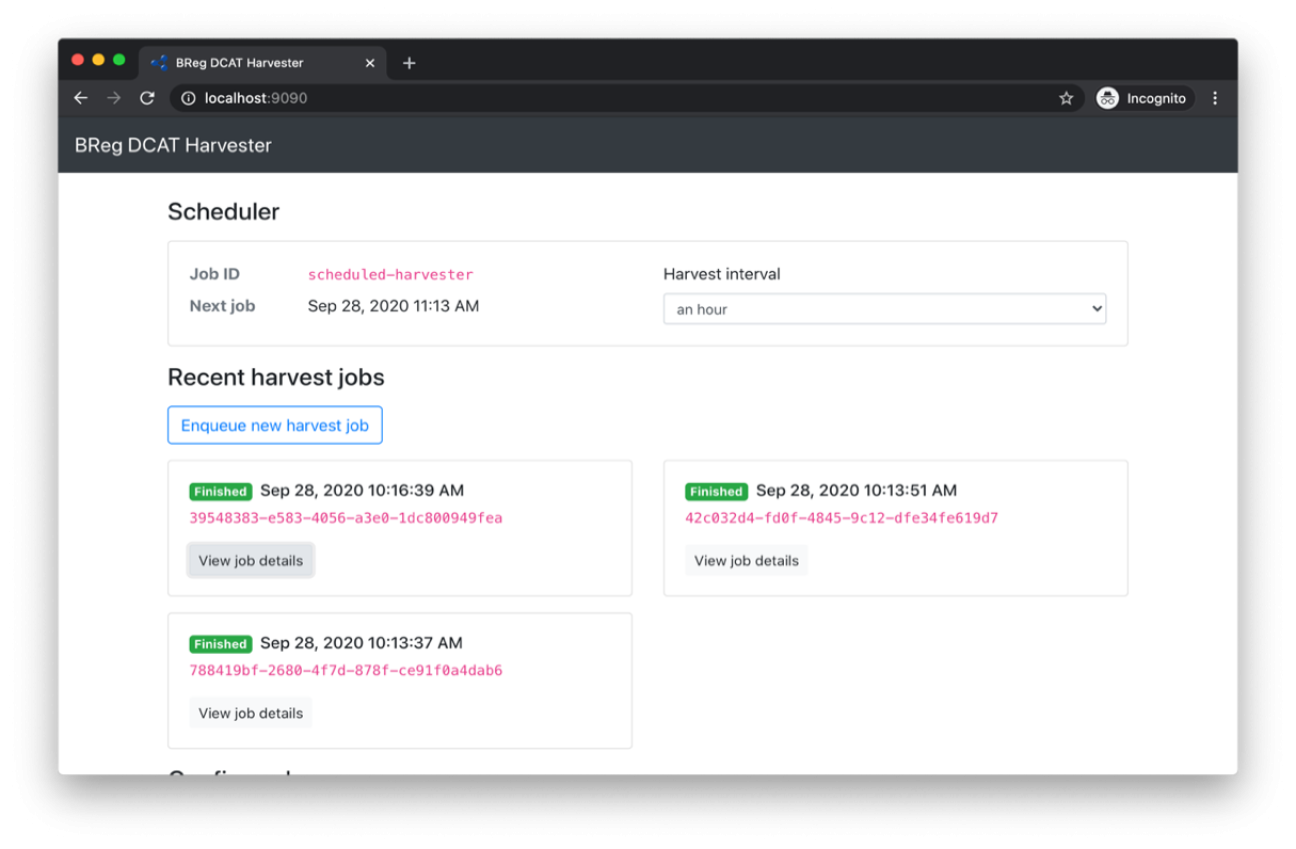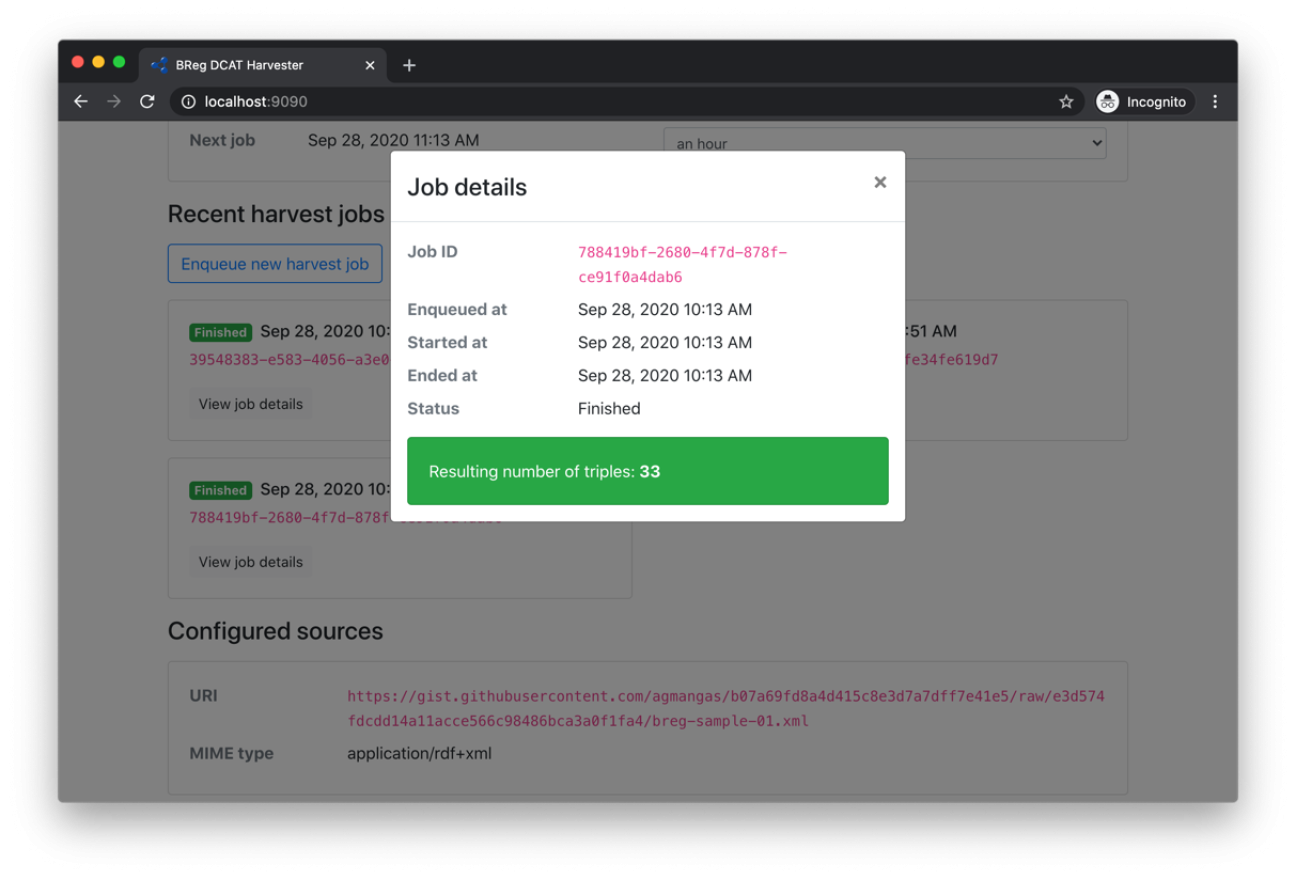[This tool is archived. This means that the tool is no longer actively maintained by SEMIC, but still available for use at own risk.]
The Harvester will allow public administrations to get the data in a faster and more efficient way, and will ease the creation of an integrated view. The main objective is to avoid the error-prone manual update process of the descriptions owned by different competent authorities on multiple levels of administration (national, regional, local) on a central catalogue.
USE-CASES
The tool covers the following use-cases:
| UC1 | Harvest remote RDF data sources. |
| UC2 | Configure automatic and periodic harvest jobs. |
More details on use-cases see here.
HIGH-LEVEL VIEW OF ARCHITECTURE
Each harvest job basically consists of three phases:
- Retrieve the data from the remote sources;
- Validate the shapes in the data sources using the ISA2 Interoperability Test Bed SHACL Validator;
- Merge the data and update the graph in the triple store.
The following diagram presents a high-level view of the architecture and typical usage flow. The user first sets the periodic harvest interval or enqueues a manual job using the Web application; these serialised jobs are kept in an in-memory Redis data store. A Queue Worker observes the Redis store, pulling and executing jobs as they become available (only one job may be executed in parallel). Finally, the results of each job execution are persisted in the Virtuoso triple store.

Figure 1: High level architecture
TECHNOLOGIES
The tool consists of the following parts:
- Redis is used as a data store to persist the serialised harvest jobs throughout their life cycle. This includes the results or error details once the harvest job finishes its execution;
- The API is developed in Python and based on Flask, a lightweight framework for the development of web applications and APIs. The rdflib library serves as the foundation of all functionality related to RDF;
- The queue implementation for the processing of asynchronous harvest jobs is based on the Python library RQ;
- The Web application that serves as a user interface is developed on top of the React JavaScript framework;
- Results of successful harvest jobs are persisted on a Virtuoso triple store.
SOURCE CODE
The source code of the tool is provisionally available on GitHub here: https://github.com/BRegDCAT-AP-Tools/breg-dcat-harvester
API
The harvester HTTP API encapsulates the main business logic of the tool, including validation, harvest, scheduling and job management. It is configured with the following set of environment variables.
Table 2: Harvester API configuration
| Variable | Description |
| HARVESTER_LOG_LEVEL | Log level of the API logger. |
| HARVESTER_REDIS | Redis URL for the jobs queue. |
| HARVESTER_SPARQL_ENDPOINT | Virtuoso SPARQL query endpoint. |
| HARVESTER_SPARQL_UPDATE_ENDPOINT | Virtuoso SPARQL update endpoint. |
| HARVESTER_GRAPH_URI | Default graph URI. |
| HARVESTER_SPARQL_USER | User of the Virtuoso triple store. |
| HARVESTER_SPARQL_PASS | Password for the user of the Virtuoso triple store. |
| HARVESTER_PORT | Port for the HTTP API server. |
| HARVESTER_VALIDATOR_DISABLED | Flag to disable the SHACL validator API. |
| HARVESTER_RESULT_TTL | Seconds that successful jobs will be kept in Redis. |
The following examples illustrate the usage of the HTTP API:
- Create a new harvest job:
$ curl -X POST http://localhost:9090/api/harvest/
{
"description": "breg_harvester.harvest.run_harvest(graph_uri='http://fundacionctic.org/breg-harvester', sources=[<SourceDataset> Type='DataTypes.XML' URI='https://gist.githubusercontent.c..., store_kwargs={'query_endpoint': 'http://virtuoso:8890/sparql', 'update_endpoint': 'http:..., validator=<breg_harvester.validator.BRegAPIValidator object at 0x7f6b68034b00>)",
"ended_at": null,
"enqueued_at": "2020-09-28T07:20:40.700335",
"exc_info": null,
"job_id": "5c47a2e3-19ad-49f8-baff-547d93e9b738",
"result": null,
"started_at": null,
"status": "queued"
}
- Fetch the current status of a previously created harvest job using the job ID provided in the POST response:
$ curl -X GET http://localhost:9090/api/harvest/5c47a2e3-19ad-49f8-baff-547d93e9b738
{
"description": "breg_harvester.harvest.run_harvest(graph_uri='http://fundacionctic.org/breg-harvester', sources=[<SourceDataset> Type='DataTypes.XML' URI='https://gist.githubusercontent.c..., store_kwargs={'query_endpoint': 'http://virtuoso:8890/sparql', 'update_endpoint': 'http:..., validator=<breg_harvester.validator.BRegAPIValidator object at 0x7f6b68034b00>)",
"ended_at": "2020-09-28T07:20:43.988582",
"enqueued_at": "2020-09-28T07:20:40.700335",
"exc_info": null,
"job_id": "5c47a2e3-19ad-49f8-baff-547d93e9b738",
"result": {
"num_triples": 33,
"sources": [{
"data_type": "xml",
"format": "xml",
"mime": "application/rdf+xml",
"uri": "https://gist.githubusercontent.com/agmangas/b07a69fd8a4d415c8e3d7a7dff7…"
}, {
"data_type": "turtle",
"format": "turtle",
"mime": "text/turtle",
"uri": "https://gist.githubusercontent.com/agmangas/5f737b17ebf97c318e2ca3b4099…"
}, {
"data_type": "json-ld",
"format": "json-ld",
"mime": "application/ld+json",
"uri": "https://gist.githubusercontent.com/agmangas/6ddc1e3405d9e890c74f2c1daf2…"
}]
},
"started_at": "2020-09-28T07:20:41.049328",
"status": "finished"
}
- Fetch the list of the most recent jobs grouped by job status:
$ curl -X GET http://localhost:9090/api/harvest/
{
"failed": [],
"finished": [{
"ended_at": "2020-09-28T07:20:43.988582",
"enqueued_at": "2020-09-28T07:20:40.700335",
"job_id": "5c47a2e3-19ad-49f8-baff-547d93e9b738",
"started_at": "2020-09-28T07:20:41.049328",
"status": "finished"
}],
"scheduled": [],
"started": []
}
- Fetch the current configuration of the scheduler:
$ curl -X GET http://localhost:9090/api/scheduler/
{
"id": "scheduled-harvester",
"interval_seconds": 432000.0,
"name": "scheduled-harvester",
"next_date": "2020-10-03T07:12:38.329589+00:00"
}
- Update the scheduler interval:
$ curl -X POST --header "Content-Type: application/json" --data '{"interval": 1800}' http://localhost:9090/api/scheduler/
{
"id": "scheduled-harvester",
"interval_seconds": 1800.0,
"name": "scheduled-harvester",
"next_date": "2020-09-28T08:15:30.650931+00:00"
}
DEPLOYMENT
Two distinct Docker Compose files are provided for deployment. The first is a self-contained stack (docker-compose.yml) that requires only for the data sources to be externally defined (see below). The second (docker-compose-lean.yml) assumes that the Virtuoso triple store is available externally, and thus does not define a Virtuoso service in the stack, expecting the configuration to be set explicitly.
Data sources are configured using the $HARVESTER_SOURCES environment variable. This variable should contain a list of lists in a JSON-serialised string. Each list item must contain two sub-items:
- The URI of the data source.
- The format of the data source as defined by rdflib. It should be one of xml, turtle, nt or json-ld.
For example:
export HARVESTER_SOURCES='[["https://gist.githubusercontent.com/agmangas/b07a69fd8a4d415c8e3d7a7dff7e41e5/raw/e3d574fdcdd14a11acce566c98486bca3a0f1fa4/breg-sample-01.xml", "xml"], ["https://gist.githubusercontent.com/agmangas/5f737b17ebf97c318e2ca3b4099c4c19/raw/5a1411286eb86a9689230ffcd3052a72fee05d74/breg-sample-02.ttl", "turtle"], ["https://gist.githubusercontent.com/agmangas/6ddc1e3405d9e890c74f2c1daf28c3fc/raw/623c2392276ecd6b86201744e1eecea324b0ef4c/breg-sample-03.json", "json-ld"]]'The data sources variable is then explicitly injected by the Compose files into the api container.
Once the data sources have been defined in the environment a new self-contained stack may be deployed with the following command:
$ docker-compose up -d --build...Creating breg-harvester_virtuoso_1 ... doneCreating breg-harvester_redis_1 ... doneCreating breg-harvester_api_1 ... doneCreating breg-harvester_worker_1 ... doneThe Web application will then be available on port 9090.

Figure 2: Harvester - Web application

Figure 3: Harvester - Harvest job details
ADAPTABILITY
The Harvester tool is reasonably agnostic to the actual RDF specification being used (in this case BREG DCAT 2.0).
If the need arises, it could be used with other RDF specifications. To this end, the user may identify two strategies:
- Disabling the SHACL validator, so all data sources that are valid RDF can be harvested and merged into the triple store.
- Implementing a new validator class to encapsulate the desired validation logic for the new specification. The RDF validation service exposed by the Interoperability Test Bed may be of use in this case.

